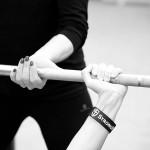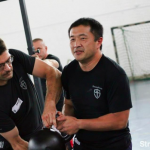How do you boost your bench press? By mastering the pause between your concentric and eccentric movements. Master SFG Dr. Michael Hartle explains why and provides two practice techniques to help teach you how.
Lower. Pause. Press Up. Repeat. Four words that could describe a lot of different things going on in that order. However, I am choosing to use them for one of our SFL Certification’s strength tests that challenge many: the bench press.

Merriam-Webster Dictionary defines the word pause as “a temporary stop.” A stop in the action. For the barbell (or kettlebell, or any other type of physical movement), it means there is no movement for a chosen period. Be it 0.5 or 5 seconds, in the bench press that pause means the barbell remains motionless. Zero upward or downward motion.
In powerlifting, the barbell must be motionless on the chest before the head referee gives the “press” signal. The world’s best benchers can stop the bar on a dime and get the signal quickly because they stopped the descent quickly. Then, after hearing the signal, press the barbell back up rapidly with very little momentum loss. Novice lifters, on the other hand, take more time because they lack experience, spending more energy during the movement.
Bench Press Pause: Why?
The main reason to pause the bar is to ensure that the athlete isn’t using momentum or elastic recoil of chest-area tissues to accelerate the bar off the chest to lockout. It helps to keep the athlete honest in their bench press activity.
“But you don’t ask us to pause the back squat, why the bench press?” The answer is simple. During any squat movement, your gluteus maximus touches nothing on the way down prior to the ascent of the squat. However, because you are laying down on your back in a bench press, the barbell contacts your chest. You decide how much or how little. I strongly suggest you stick to the latter part of that last statement.
W=Force x Distance
I’m a proponent of working smarter, not harder when doing a specific task. Understand that I’m not talking about not working hard—I’m talking about working smart.
When thinking about the bench press, I want you to visualize the distance the bar must travel from lockout to your chest. Besides getting your setup dialed in before even unracking the bar (that’s another article), the shorter distance that the bar must travel results in less total work being done by you.
For example, if the bar must travel 12 inches (1 foot) from your chest to lockout, and the weight is 300 pounds, the resultant work is 300 ft-lb. Allowing the bar to sink into your chest one inch during the pause increases the lockout distance the bar must move to 13 inches (1.083 feet). This results in 324.9 ft-lb of work needed to raise the bar to lockout. This extra 24.9 ft-lb is a lot of unnecessary work. In one set of 5 repetitions, that amounts to 124.5 ft-lb of extra work.
The point I am trying to make here is when you have the bar travel a farther distance, you will generate more work to lock it out than if you had stopped the bar just when it touched your chest. And a lot more work if you are doing a multiple rep set.
Meet the Bar Halfway Down
In every facet of StrongFirst, we teach you to be active during the eccentric phase which translates to a stronger concentric phrase.
During the teaching part of the bench press, we explain how to “meet the bar halfway down.” As you lower the bar under control and as it approaches your chest, imagine you are sticking your chest (and thoracic spine) up higher and higher. Doing this results in a stronger contraction in your lats, and corresponding scapular retractors and depressors. It also places a bigger stretch on your anterior pressing muscles, namely the pecs. This increases the stretch reflex, thereby creating greater pressing ability off of your chest.

This is why during the bench and military press part of the SFL, I state that when I lower the bar, I visualize having to “pull the bar down” while “meeting the bar halfway down.” I also say I barely want to reach the bar to my chest. This visualization helps me to stay tighter under the bar and to achieve my goal—stopping the bar quickly and efficiently, to press the bar up strongly.
L-O-N-G Pause
One exercise I like to use for students having difficulty mastering the quick bar stop on the chest is the elongated pause.
This is very similar to the long stoppage in the squats and done for a similar reason. Lengthening the pause, to three seconds, for example, gives the student a better understanding of what they are trying to achieve.
You will need lighter weight and have a spotter, not only for helping you lockout if needed (you shouldn’t be going that heavy) but also to count out loud for you. Again, very similar to the squats.
Doing these longer pauses also gives you and your spotter a chance to check your form. If during the three seconds your foot moves, you lose your abs or arch, then these are areas you will need to address before going heavier. Using lighter weight also decreases your chance of injury.
After spending at least four weeks with the longer pause, shorten it to the required one second/“bar is motionless” pause. You will see how much more effective you are as a bench presser!
No Presses Left Behind
Apply these techniques to the standing military press, with the obvious technique changes, and your press will go up much stronger. Using these drills with the kettlebell press and even the bodyweight pushup will also yield great results. That’s the power of principle-based strength training—they transcend the modality.
Give them a try and let us know how your bench, military, or kettlebell press feel in the comments below or on our StrongFirst Forum.





Great article Doc thank you.
I’m 57 and very excited that there is now a masters division for the SFL.
I’ve got everything down except for the bench press. Based on my weight I will have to bench 185-190 lbs. I’m not even close yet but articles on this site will definitely help me along with KB presses, push-ups and/or whatever my coach recommends. I don’t think I’ll be able to make it to the Dome of Strength in Chicago this Spring but had an awesome weekend there last year at the SFG cert…What an experience! I did meet you at Ryan Toshner’s gym a couple years ago at the TSC and look forward to seeing you again.
Best regards,
Steve Wuertemburg